In July 1942 Australia had just two Militia brigades in Port Moresby, the administrative centre of Papua. In that month the Japanese landed troops at Buna and Gona on the Papuan north coast and in the following month they landed another force at Milne Bay.
The barrier between the Japanese forces in the north and Port Moresby on the south coast was the Owen Stanley Range - a steep, rugged series of mountains crossed only by a few foot tracks, the most important of which was the Kokoda Track. At the end of June, one thousand Militiamen, ‘Maroubra’ force, had been ordered to hold Kokoda and its airfield against any possible Japanese attack - but this proved an impossible task.
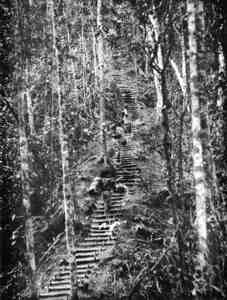
Like to copy this image? Please click here first
AWM P02423.009 Imita Ridge, Papua, 1942. Two native carriers and a member of 2/4th Field Ambulance slowly climb the so-called ‘Golden Stairs’ - on the Kokoda Track - towards Ioribaiwa. Each step was battened at its edge by a rough log which was sometimes broken and often slippery with a coating of mud. In climbing the stairs, soldiers had to lift their leg over the log and put their foot down on the step behind in what was frequently a puddle of mud and water up to six inches deep.
By the end of July the Militia were carrying out a fighting retreat and it was not until late in August that reinforcements from the 7th Division A.I.F. began to reach them. The A.I.F. men, trained for desert warfare, found the country more frightening than they found the Japanese. Confusion was created by Japanese advances through the trackless jungle on the flanks of positions the Australians were prepared to defend.
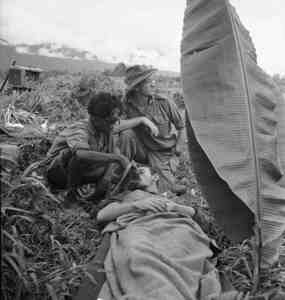
Like to copy this image? Please click here first
AWM 13600 Papua, 1942. A wounded digger is given a drink by a "fuzzy wuzzy angel" as he waits to be evacuated by plane. Leaves stuck in the ground provide shade for him
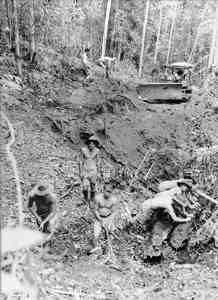
Like to copy this image? Please click here first
AWM 026310 Papua, 1942. Sappers of the 2/14th Australian Field Company Royal Australian Engineers, who had built roads through the snow-clad mountains of Syria, engaged in pushing a road through the dense jungle between Port Moresby and Kokoda.
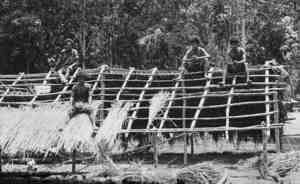
Like to copy this image? Please click here first
AWM P02423.017 Kokoda, Papua, 1942. Native Papuan labourers sitting on the framework of a grass hut that they were building as a hospital ward for the Main Dressing Station (MDS) of the 2/4th Field Ambulance.
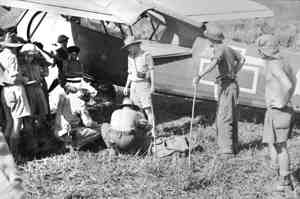
Like to copy this image? Please click here first
AWM P02424.082 Kokoda, Papua, 1942. Medical personnel making last minute adjustments to ensure that a sick or wounded Australian soldier is secure and comfortable for an air evacuation flight to Port Moresby aboard a United States Army Air Force (USAAF) Stinson L-1 Vigilant ambulance aircraft. Partly obscured is a large Red Cross sign painted on the side of the aircraft’s fuselage to indicate its medical function.
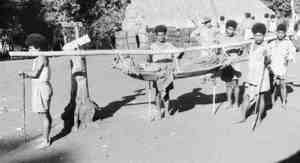
Like to copy this image? Please click here first
AWM P02424.020 Uberi, Papua, 1942. A group of native Papuan carriers about to evacuate a wounded Australian soldier on a stretcher along the Kokoda Track from Uberi to the start of the motor road at Owers Corner. The stretcher is slung below a single carrying bar supported at each end by one of the carriers. Known colloquially as ‘fuzzy wuzzy angels’, the carriers worked in teams of eight under the supervision of a native ‘boss boy’.

Like to copy this image? Please click here first
AWM 026320 August 1942. Wounded members of the 39th Australian Infantry Battalion making their way back along a jungle track to the base hospital. They are all suffering from gunshot wounds sustained in the fighting against the Japs in the Kokoda area. To reach the hospital area they had to walk for nearly six days through thick jungle.

Like to copy this image? Please click here first
AWM 026852 Papua, September 1942. 25-Pounder guns of B Troop, 14th Field Regiment, Royal Australian Artillery, being pulled through dense jungle in the vicinity of Uberi on the Kokoda Track. They are being assisted by the 2/1st Australian Pioneer Battalion.
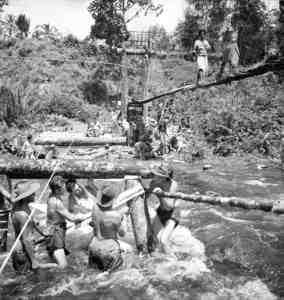
Like to copy this image? Please click here first
AWM 013598 Kokoda, November 1942. Engineers building a bridge - one of the many that were necessary along the track from Kokoda to Buna.
By mid-September the Australians had dug in at Imita Ridge, fifty kilometres from Port Moresby, and were ordered to hold that position. A fight to the death was expected but the Japanese, lacking sufficient supplies and fearing an American attack on their base at Buna, began to withdraw.
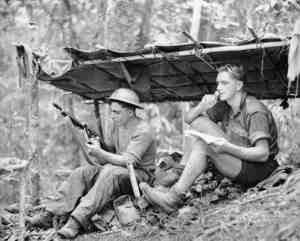
Like to copy this image? Please click here first
AWM 026727 Papua, September 1942. Men of the 2/14th Infantry Battalion resting under a makeshift shelter near their positions on a ridge overlooking the valley leading to Ioribaiwa. One cleans his automatic Thompson sub-machine gun while the other tries to write a letter home
During November the Australians were pursuing the Japanese through the stinking mud and treacherous, slippery tracks as they went back along the Kokoda Track. The Japanese advance through the rain-sodden jungles of Papua had been turned into a retreat but, even though many of them were sick and starving, it was always a fighting retreat. Most of the hardest fighting was around Buna and Gona where they had determined to fight to the death to maintain a foothold in Papua.
The Australian advance was aided by the American 32nd Division which established bases to the south of Buna while the Australians pushed on down the Kokoda Track and across country from Wanigela. Gona was taken on 9 December and on 2 January 1943 Buna was captured. Sanananda, held by 600 Japanese, was not taken until 12 January. The Papuan campaign ended with the surrender of Japanese survivors on 22 January.
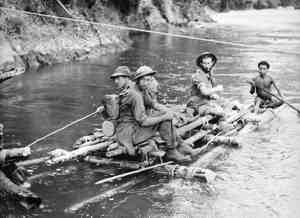
Like to copy this image? Please click here first
AWM 069246 Kalikodobu, October 1942. A party of the 2/14th Infantry Battalion using a raft to reach the United States base camp. The men and their party were cut off from the main body of troops during the withdrawal across the Owen Stanley Range. In the final stages of the withdrawal in August, the party used rafts built by friendly natives to move down the Kemp-Welch River to safety after being in the jungle for 42 days.
Out of a force of about 20,000 the Japanese had lost 13,000, most of whom had fought to the death rather than surrender. The campaign cost Australia over 6000 casualties. Tropical diseases, as much as the fighting, had taken their toll on both armies.
Extract from Robert Darlington. Sudan to Vietnam. Shakespeare Head Press, Sydney, 1987.





